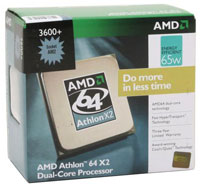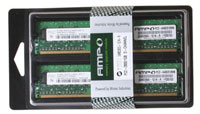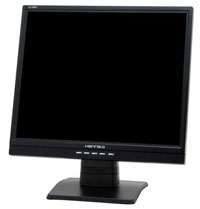Entry Level AMD
The great thing about purchasing a computer right now is that you can get a serious amount of performance for a reasonable price. Our entry level configuration will look to keep price as low as possible without making any major compromises. However, without spending a bit more money it is impossible to purchase a basic computer that will do everything well. The biggest compromise we are making is in the graphics department, where the use of integrated graphics basically means that gaming performance is going to be crippled. For the many people out there that don't care about games, that shouldn't present a problem. It is also relatively simple to upgrade a computer with a discrete graphics card in the future should the need/desire arise.
| AMD Entry Level System |
| Hardware |
Component |
Price |
Rebates |
| Processor |
Athlon 64 X2 3600+ AM2 (Brisbane 1.9GHz 2x512K) - Retail |
$72 |
|
| Motherboard |
ASUS M2A-VM (Socket AM2 AMD 690G) |
$77 |
|
| Memory |
WINTEC AMPO 2x512MB DDR2-800 (5-5-5-12 3AMD2800-1G1K-R) |
$65 |
|
| Hard Drive |
Western Digital Caviar SE16 WD2500KS 250GB 16MB |
$70 |
|
| Optical Drive |
Lite-On 20X DVD+R LH-20A1P-185 |
$34 |
|
| Case |
RAIDMAX APEX ATX-802BP with 450W PSU |
$65 |
|
| Display |
Hanns-G JC-199DPB 19" 8ms (1280x1024) |
$184 |
$40 |
| Speakers |
Cyber Acoustics CA3001WB 14 watts 2.1 Speakers |
$24 |
|
| Keyboard and Mouse |
Microsoft Comfort Curve 2000 B2L-00047 |
$28 |
|
| Operating System |
Windows MCE 2005 or Vista Home Premium (OEM) |
$115 |
|
| Bottom Line |
|
$734 |
$694 |
 |
Prices on AMD's dual core processors are now so low that we see little reason to avoid them. You could shave another $20 off the price by going with a single core Athlon 64 3000+, but that extra $20 buys you potentially twice as much performance. Dual core and multi-core processors are the future, and for those planning to purchase an inexpensive computer and use it for years to come we would just spend the extra money now. The Athlon X2 3600+ (Brisbane core) runs at 1.9GHz and comes with 512K cache per core. Do not confuse this with the 2.0GHz 256K version (Windsor core); the extra cache will almost certainly prove more useful than the extra 100 MHz. For those looking to really cut costs, if you don't want a dual core processor you might as well drop all the way down to the Sempron 64 3000+ (1.6GHz 256K cache) that costs a mere $33. Just don't expect that processor to handle the demands of many applications in three years' time.
 |
Perhaps the most difficult component to get right in any custom-built system is the motherboard. This is particularly true when looking at the budget sector. Buying the least expensive option is rarely the best course of action as features, reliability, stability, and performance can all be compromised. Luckily, the situation is generally better now than it has been in the past, and the integrated memory controller on AMD's processors usually means features and reliability are the only major concerns. For the current cost, the features and performance offered by AMD's 690G chipset put it at the top of our list. Besides a reasonably performing IGP solution - arguably the fastest currently available, though that isn't saying much - you can get VGA, DVI, as well as HDMI video outputs. The ASUS M2A-VM is a micro ATX solution with most of these features, available at a bargain price of only $77. Adding HDMI support will increase the price about $20. It certainly isn't one of the "everything but the kitchen sink" designs, though you can't usually find that without moving beyond the budget sector. This motherboard should also allow at least a moderate amount of overclocking if that's of interest, but that isn't a primary concern here.
 |
We chose DDR2-800 memory, simply because the cost is now at parity with other slower DDR2 memory (i.e. DDR2-667). Memory prices have also become much more reasonable since the beginning of the year, and we're back at the point where 2GB of RAM is available starting at just over $100. We decided not to go that far on entry level configuration, but if you're thinking about running Windows Vista as opposed to Windows XP we would strongly recommend upgrading the memory. On the bright side, at least even micro ATX motherboards are generally offering four DIMM slots these days. For the majority of users, memory timings and overclocking definitely aren't concerns in the budget sector, so we selected an inexpensive Wintec AMPO kit.
For the remaining items, we tried to keep the price down while keeping features and performance as high as possible. We could certainly trim things a bit further (for example getting a 160GB or even 80GB hard drive can save $15-$20), but we prefer to spend slightly more if possible. Getting a less expensive case is something else to consider, and of course those who prefer a little bling have plenty of budget options available. Provided you just want to stay with the basics, you can basically get any cheap case plus power supply and not have any difficulties, but we would still pay attention to user reviews and experiences and do a bit of research first.
 |
The only other major component remaining is the display, and here we were presented with several options. 17" LCDs are the least expensive choice right now, but once you factor in mail-in rebates it really only costs a few dollars more to get a 19" LCD. Some people might actually like the slightly smaller LCD for whatever reason, but we would definitely take a larger LCD first. Looking at the 19" LCDs, you then have to decide between standard aspect ratio and widescreen offerings. We like widescreens for the most part, but it seems like corners are being cut on the panels in order to keep costs down, and actual surface area is slightly larger on a standard aspect ratio display. Hanns G is one of many display manufacturers that most people aren't familiar with, but the reality is that there are only a few actual panel manufacturers. The quality of LCD panels has also reached the point where even the budget offerings look good and perform well. Long-term quality and support is a bit harder to judge, but the average user consensus is that this particular LCD is a very good budget option.














46 Comments
View All Comments
xsilver - Monday, April 23, 2007 - link
A quick mention of the possible headroom on the 2x1gb Jetram would have been nice?eg. does it overclock to cas 4? or does it OC to ddr900? or both? or none?
amking0 - Saturday, April 21, 2007 - link
with all the recent price cuts and rebates floating around, i've finally decided to leave my single core a64 system behind and do an upgrade to something along the following lines:e6600
650i board (probably)
2 gb corsair ddr2-800
old 7800 gt for the time being
just wanted to comment about the x-fi issues you mentioned in the article tho (since i just ordered one on sale + a $50 rebate) ...you have me worried now D:
i'm also pondering the move to vista, but i guess i might be sticking with xp a little longer now.
yyrkoon - Monday, April 23, 2007 - link
Why not just use onboard Audio ? I find it hard to belive that anyone could tell the difference between onboard, and descrete audio. regardless, I have had my last several system, all with onboard audio, and dropped in the random audio card, only difference I could tell, was about 3-5FPS in Oblivion, other than that, no difference.FrankM - Saturday, April 21, 2007 - link
"We tossed around several brands, including SeaSonic and Silverstone, but in the end we selected the Corsair 520W."Actually, that Corsair is a rebranded SeaSonic...
If only reliability and stability is the issue for the PSU for overclocking, there are cheaper quality PSUs available; the real strenght of the Seasonic/Corsair is the high efficiency and very low noise.
JarredWalton - Saturday, April 21, 2007 - link
I actually did know that (that it's a rebranded SeaSonic), but didn't think it was necessary to go into the details. Basically, I was looking at some PSUs in the range of $100 shipped, and figured at that point the extra $15 was money well spent to get a very high quality PSU. The SeaSonic model was $15 more than the Corsair, IIRC, so no reason to pay more for the same PSU.yyrkoon - Monday, April 23, 2007 - link
The Antec EA500W earthwatts PSU can be had for less than $50 usd(after rebate), and had a very favorable review from JonnyGuru. I use one myself, but I am not exactly using it harshly (midly OC'd Opteron 1210, and a 7600GT, 7 HDDs, and an optical). Seems fine so far, but is only about 3-4months old.deathwalker - Saturday, April 21, 2007 - link
Good grief, since when did a $400 video card fit in the catagory of a Mid-range product? Im going to have to research past guides for mid=range systems to see if AT has just completely broken the mold.JarredWalton - Saturday, April 21, 2007 - link
It specifically is targeting the gaming market. As mentioned, the 8800 GTS 320 is a $120 cheaper option that you might consider. For games, though, the GPU is the bottleneck 95% of the time, so you should get as much GPU power as possible.Ronson - Friday, June 8, 2007 - link
If a $400 Graphics card is gaming then what are the cheaper cards for? Office use? A $200 Graphics card would have been more reasonable. The $400 card really just belongs in the High End guide.yyrkoon - Saturday, April 21, 2007 - link
AMD Athlon 64 X2 3600+ Brisbane - $72.00
ABIT NF-M2 nView - $94.99
CORSAIR XMS2 2x1GB DDR2 800 - $122.00
Seagate Barracuda 250GB - $67.99
Total - $356.98
Migrate optical drive, Case, PSU, Keyboard, mouse, and monitor from old system, because if you're reading here, you have a computer already, OR, you are using a friends PC, in which case you need to buy a Dell. All parts are free shipping, from newegg.
I have to say, I must question your choise of motherboard for the 'budget'/ entry level AMD system. It has been my experience, that anything this inexpencive from ASUS, or ASROCK, is nothing but a piece of junk, with very little driver / BIOS support, if any at all. Not to say the ABIT board I have chosen has had much driver / BIOS support, but it is rock solid, and has many features that put other boards a class or two above to shame. Anyhow . . . </fanboyism>